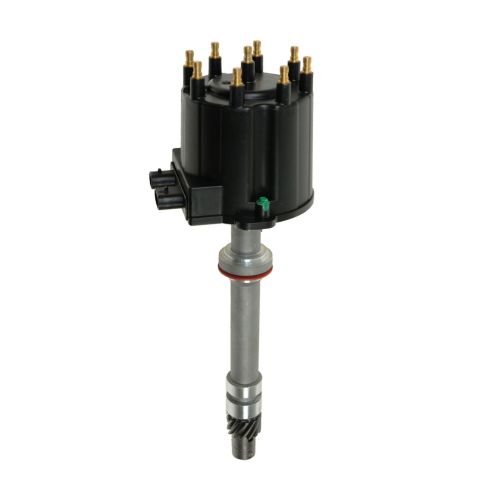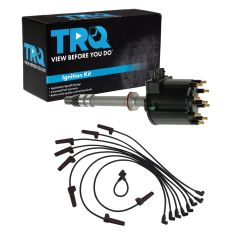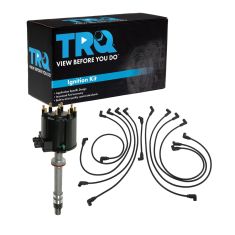1AEDI00070-Chevrolet GMC Cadillac Pontiac Distributor TRQ EDA64949
Replaces
1990 GMC C3500 Truck V8 7.4L Distributor TRQ EDA64949
Product Reviews
Loading reviews
4.93/ 5.0
30
30 reviews
Well Worth
February 11, 2017
Great stock replacement, had it for a year with no issues.
June 30, 2017
Bought and installed this a month ago, no issues and the price was great!
Perfect fit
November 15, 2017
looks just like the one I took out fits great. It was plug & play
Ok
March 15, 2018
Yes i did like your how to videos and your parts i have been really happy with your product ty
Distributor
March 24, 2018
This seems to be good quality...but watch out for what cap wires you have because these have the wrong terminal type for my wires....1A-Auto did everything they could to make it correct even let me return if I wanted to...Will do business with this company again
March 29, 2018
Yes i would the company has been very good to me and the prices are very good also thanks you very much for helping me out god bless u all Marvin
distributor
June 22, 2018
This is the 4th purchase from 1a auto and I have had great service and everything has worked perfect precept for 1 time but even then they replaced the item quickly with no charge to me. This distributor was a perfect match and was cheaper than if I bought all the pieces to rebuild. Great experience.
better then a parts store
August 28, 2018
I've ordered from alot of places. But these guys are on top of things. I had my part so quick it really threw me and really made me question why I even bother with parts stores. And last but not least. I saved 120.00 buying from these guys that in itself is a game changer. Thanks you guys.
Great Product
September 29, 2018
Item is as described. Fit our motor and arrived as stated. We have purchased before and are very satisfied with items ordered and item always arrives as stated.
Excellent part perfect fit
October 19, 2018
Excellent customer service. Good products excellent shipping great pricing great parts.
Perfect!
October 20, 2018
I put the distributor in, engine fired right up, great product at a great price!
Distributor purchase
November 13, 2018
My purchase worked perfectly and I would recommend any and all to purchase this product from you if in need of one. Fast delivery and correct product for what was needed.
Excellent quality and the fit was excellent
December 19, 2018
This part was just the absolute right one it fit so well just like the original factory GM parts , even though it takes a little while to get to you , however its truly worth the wait and once you make your first order and the quality that 1a gives you'll be hooked on their quality ,service and be satisfied . Shop here and leave the rest alone .
great sevice
December 24, 2018
your people were very helpfull & the srrvice was great
February 11, 2019
Very happy with my purchase love 1A Auto will continue to buy from them very fast shipping and great quality in the product
February 16, 2019
I was looking around for a distributor that was in my budget and I found it. It fit perfectly with in ten minutes had the truck running perfectly. It only took two days for it to come in. The overall performance is as expected.
Thanks
February 26, 2019
Great product. Worked fine price was very nice. Will buy more products. ThanksWrite
Excellent parts good prices
May 15, 2019
Awesome parts second part ordered, half the price of in town and always work great. Ordering more parts from them for sure.
July 7, 2019
Awesome. My electronic module went out I had another one sent to me in 2 days had me up and running again in no time. Love 1aauto I recommend to all my friends theyve already been buying parts.
Easy install, great price
June 15, 2020
So far so good, dropped right in and has my truck running great again.. thanks
Distributor
November 12, 2020
Perfect replacement for my 1990 Chevy C-1500 5.7 engine. Good quality at a fair price, and very fast delivery.
Although this didn't necessarily solve all the problems I was having, I thought it would be a good idea to replace it regardless, to at least help eliminate one possible problem. (I don't have a OBD1 scanner) I'm hoping to buy one that can scan both, OBD1 and OBD2.
Small block distributor
November 13, 2020
Came early and was exactly as described works perfectly I would buy again
As expected.
December 29, 2020
I order from here all the time. Front end kits, distributors, rotors, and about everything else. Arrives right and on time.
Distro and Coil
May 18, 2021
Perfect fit and finish! Quick delivery as well.
Very pleased
September 21, 2021
It shipped fast, great price, no issues, no "surprises".
Dropped it in, hooked it up, set the timing, and it runs like a top. Great product.
Great deal
November 27, 2021
It works great
[{"url": "https://wac.edgecastcdn.net/001A39/prod/media/pNISJll75W64CYGsite/fcc0d6cf10843b547a0c08f44bf7b7b9_1652774454437_0.jpeg", "caption": ""}]
May 17, 2022
Looks just like the old one.
Great buy
[{"url": "https://wac.edgecastcdn.net/001A39/prod/media/pNISJll75W64CYGsite/3afc78a7949e7fa5cacb83307e4a1fd4_1661601561050_0.jpeg", "caption": ""}]
August 27, 2022
Great product , for a great buck ?? got it for my 89 Formula 350 and looks IDENTICAL. Very satisfied works great thanks ????
Great
September 21, 2022
Worked perfect easy to install
October 11, 2023
Fit perfect and solved my issues!
Truck would die at idle at times.
Customer Q&A
What name brand is this distributor ?
April 10, 2016
10
didnt see a brand name on it
April 10, 2016
Gary H
10
We have a few different aftermarket companies build these parts specifically for us, as our 1A Auto house brand. They are manufactured to the same OEM specifications as the original part that came with your vehicle and are covered by a lifetime warranty. If you have any further questions, please don't hesitate to ask.
April 11, 2016
Brian F
engine
code E ? which means tbi fuel injection
March 8, 2018
10
Throttle body injected
March 9, 2018
Darren K
Will this work in a marine engine? I would install a marine cap- but Id all else the same?
June 22, 2019
10
The parts were designed for and should only be used in the listed applications in the fit chart.
June 22, 2019
Preston C
Who makes the GMC distributor,i have had 3 bad ones made by spectrum?
July 14, 2020
10
1A Auto's house brand parts are manufactured by various aftermarket companies specifically for us and built to your vehicle's exact OEM specifications. Please let us know if you have any other questions.
July 14, 2020
T I
Does it come with rotor button?
August 6, 2021
10
Yes, this is the complete assembly.
August 6, 2021
Adam G
IS IT COMPLET ?
September 21, 2021
10
Yes, just drop it in, plug it in and set timing. Button, rotor, pickup, cap, everything is there.
September 21, 2021
B L
Does it come with the gasket?
January 13, 2022
10
Yes this part will come with the o ring as pictured.
January 13, 2022
T I
10
No no
January 13, 2022
Debra S
GMC is a registered trademark of General Motors Company. 1A Auto is not affiliated with or sponsored by GMC or General Motors Company.
See all trademarks.









